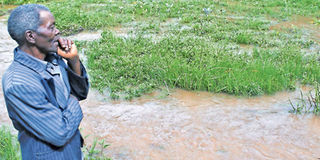Agronomist notebook: How to manage effects of floods on your farm

Mwangi Kabiru on his flooded two-acre farm in Elburgon. Despite floods being a natural calamity, one can overcome them through proper planning. PHOTO | JOHN NJOROGE | NMG
What you need to know:
- During land preparation, consider creating runoff or sediment traps to reduce the likelihood of the farm flooding. This is done by creating channels that direct the water to a harvesting site or a nearby water source.
- Terraces can be used to reduce the steepness of a hillside and retain the surface water that would otherwise run off the sloping land.
- Farmers should also focus on having vegetation on waterways to help curb the erosive force of runoff. The vegetation helps absorb water’s destructive energy, thus preventing soil erosion and gully formation.
- Farm produce and inputs should be placed in areas above floodwater level. Normally, when there is flooding and soil erosion, leaching of nutrients occurs, which makes the plant show some deficiency symptoms.
With the ongoing heavy rains across the country, farmers are among the worst affected.
To begin with, most farms are currently flooded with rainwater, with the rains damaging crops or washing them away.
Marketing of agricultural products has also become a nightmare as most roads to farms are inaccessible. Some farmers are, therefore, watching as their harvest rots on the farm.
But despite floods being a natural calamity, you can overcome them through proper planning.
During land preparation, consider creating runoff or sediment traps to reduce the likelihood of the farm flooding. This is done by creating channels that direct the water to a harvesting site or a nearby water source.
While creating the channels, avoid directing the water to the road as this increases erosion of the soil.
If your area is prone to flooding, consider making beds on which you grow your crops as this will help prevent the plants from being washed away.
As a mitigation measure, always have an appropriate plan to prepare the land before heavy rains begin. However, this can be problematic as the rains have become unpredictable.
Nevertheless, it is ideal to farm before heavy rains start since tractor implements can’t work on muddy land. Also, working on wet soil results in formation of hardpans, making operations difficult.
Planting crops and trees around the farm helps to reduce the impact of soil erosion since the latter holds the soil particles together.
Crops that form a groundcover such as sweet potatoes, desmodium, and grass should also be grown on bare grounds to minimise soil erosion.
Terraces can be used to reduce the steepness of a hillside and retain the surface water that would otherwise run off the sloping land.
Contour farming along a slopy land also helps to control soil erosion. This involves planting crops on nearly the same level of elevation.
The effectiveness of this technique varies from one region to the other but helps to retain the soil moisture and reduce the soil erosion.
ON THE LOOKOUT
Farmers should also focus on having vegetation on waterways to help curb the erosive force of runoff. The vegetation helps absorb water’s destructive energy, thus preventing soil erosion and gully formation.
In waterlogged areas, one should consider planting trees such as eucalyptus that require a lot of water.
Consider strip cropping, which involves cultivating a field partitioned into long, narrow alternated strips. This method is used where the slope is too steep to prevent soil erosion.
The crops to be planted include wheat and other forages which are alternated with strips of row crop such as soybeans.
One should relocate livestock to a higher ground to prevent them for being washed away by floods. Farm machinery should also be kept at high levels under a shed to ensure they remain safe.
Farm waste such as chemical bottles should be well-disposed of to prevent contamination of rivers.
Farm produce and inputs should be placed in areas above floodwater level. Normally, when there is flooding and soil erosion, leaching of nutrients occurs, which makes the plant show some deficiency symptoms.
To prevent this, farmers must spray their crops with foliar fertiliser as the plants absorb the nutrients through the leaves.
While spraying, the foliar should be mixed with a sticky substance so that it is not washed away by the raindrops before the plant takes up the nutrients. The same case applies while spraying fungicides and pesticides.
Farmers should be on the lookout for pests and diseases likely to affect their crops.
For instance, the spread of fungal diseases is very high during this rainy season. Tomatoes have profoundly been affected by early and late blight.
In this case, prevent the occurrence of the disease by ensuring that you observe all the farm hygiene practices and ensure you spray fungicides to prevent the occurrence of the diseases.
Affected leaves should also be removed and properly disposed of to prevent the spread of the disease.
For greenhouses, the drainage systems should be well managed by creating proper channels as surface runoff could result in the entry of pathogens from the nearby fields.
This would probably transmit soil-borne diseases such as fusarium and bacterial wilt into the greenhouse.




